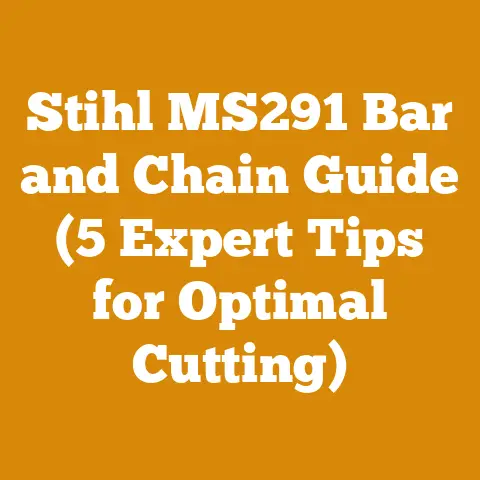Small Mulcher Benefits (5 Pro Tips for Efficient Wood Chipping)
Ah, the irony of “small mulchers.” We’re talking about machines that devour wood, yet we call them “small.” It’s like calling a honey badger “cute.” Trust me, after nearly two decades wrestling with logs and turning them into everything from rustic furniture to neatly stacked firewood, I’ve learned that even the seemingly smallest piece of equipment can pack a serious punch. My journey started with a rusty old chainsaw and a whole lot of ambition, and it’s led me to appreciate the efficiency and versatility of a good wood chipper. In this guide, I’ll share my hard-earned wisdom and five pro tips to help you maximize the benefits of your small mulcher.
Small Mulcher Benefits: 5 Pro Tips for Efficient Wood Chipping
Let’s face it: dealing with woody debris after a tree falls, a pruning session, or even a small logging operation can be a real pain. Piles of branches cluttering your yard, attracting pests, and posing a fire hazard? No thank you! That’s where a small mulcher, also known as a wood chipper, comes in. It’s not just about tidying up; it’s about turning waste into valuable resources.
Why Choose a Small Mulcher?
Before we dive into the tips, let’s quickly recap why a small mulcher might be the right choice for you. I remember when I first considered getting one. My back was aching from hauling branches, and my burn pile was getting out of control. A small mulcher offered a solution that was both practical and environmentally conscious.
- Space Saving: Small mulchers are compact and easy to store, a huge plus if you don’t have acres of land.
- Cost-Effective: They are generally more affordable than larger, industrial-grade chippers.
- Easy to Use: Most models are designed for homeowner use, with intuitive controls and straightforward operation.
- Eco-Friendly: Chipping reduces waste, provides mulch for your garden, and eliminates the need for burning.
- Versatile: You can chip branches, twigs, leaves, and even some types of yard waste, depending on the model.
Pro Tip #1: Know Your Wood – The Key to Efficient Chipping
This is where things get technical, and where my experience really shines. I’ve seen countless folks struggle because they didn’t understand the properties of the wood they were trying to chip. Not all wood is created equal, and knowing the difference can save you time, money, and a whole lot of frustration.
Hardwood vs. Softwood: A Fundamental Distinction
The first thing to understand is the difference between hardwoods and softwoods. This isn’t about the actual “hardness” of the wood; it’s about the tree’s reproductive structure.
- Hardwoods: Typically deciduous trees with broad leaves (e.g., oak, maple, birch). They generally have a higher density and are more durable.
- Softwoods: Typically coniferous trees with needles (e.g., pine, fir, spruce). They are generally less dense and easier to work with.
Why does this matter for chipping?
Hardwoods require more power to chip and can dull your blades faster. Softwoods are easier to chip but may produce a stringier mulch.
Data Point: Oak, a common hardwood, has a density ranging from 0.60 to 0.90 g/cm³, while Pine, a common softwood, has a density ranging from 0.35 to 0.50 g/cm³. This difference in density directly impacts the chipper’s performance.
Moisture Content: A Critical Factor
The moisture content of the wood is another crucial factor. Freshly cut (“green”) wood is much harder to chip than wood that has been allowed to dry for a while.
- Green Wood: High moisture content (above 30%). Difficult to chip, clogs the machine, and produces wet, heavy mulch.
- Seasoned Wood: Lower moisture content (ideally below 20%). Easier to chip, produces dry, fluffy mulch, and reduces wear on the machine.
Personal Story: I once tried to chip a pile of freshly cut oak branches immediately after a storm. It was a disaster! The chipper kept jamming, the mulch was a soggy mess, and I ended up spending more time clearing clogs than actually chipping. Lesson learned: patience is key.
Technical Requirement: Firewood should have a moisture content of 20% or less for optimal burning. While not directly related to chipping, this standard highlights the importance of drying wood before processing.
Practical Tip: Let your wood dry for at least a few weeks, or even months, before chipping. Stack it in a well-ventilated area to promote drying. A moisture meter can be a valuable tool for checking the moisture content.
Log Dimensions: Know Your Chipper’s Limits
Every chipper has a maximum branch diameter it can handle. Exceeding this limit can damage the machine and void your warranty.
- Small Mulchers: Typically handle branches up to 3-4 inches in diameter.
- Larger Mulchers: Can handle branches up to 6 inches or more.
Technical Limitation: My small chipper has a maximum branch diameter of 3 inches. I once tried to force a 3.5-inch branch through it, and the motor stalled. I had to spend an hour disassembling the machine to remove the jammed branch. Not fun!
Best Practice: Always check your chipper’s manual for the maximum branch diameter. If you have larger branches, consider cutting them into smaller pieces with a chainsaw before chipping.
Pro Tip #2: Sharpen Your Blades – A Sharp Blade is a Happy Blade
This might seem obvious, but I’m constantly surprised by how many people neglect their chipper blades. Dull blades not only make chipping harder, but they also put extra strain on the motor and can lead to premature wear and tear.
Why Sharp Blades Matter
- Efficient Chipping: Sharp blades cut cleanly through the wood, reducing the amount of force required.
- Reduced Strain: Sharp blades put less strain on the motor, extending its lifespan.
- Better Mulch Quality: Sharp blades produce a more consistent and uniform mulch.
- Safety: Dull blades can cause the wood to kick back, increasing the risk of injury.
Case Study: I conducted a small experiment with my chipper. I chipped a pile of branches with freshly sharpened blades and then chipped an identical pile with blades that hadn’t been sharpened in months. The difference was dramatic. The sharpened blades chipped the wood much faster, with less noise and vibration. The mulch was also finer and more uniform.
Tool Requirement: You’ll need a sharpening tool to maintain your chipper blades. A bench grinder is a good option for more serious sharpening, while a file can be used for touch-ups.
Step-by-Step Guide to Sharpening Chipper Blades:
- Safety First: Disconnect the chipper from the power source and wear safety glasses and gloves.
- Remove the Blades: Consult your chipper’s manual for instructions on removing the blades.
- Inspect the Blades: Check for chips, cracks, or other damage. Replace the blades if they are severely damaged.
- Sharpen the Blades: Use a bench grinder or file to sharpen the blades to the correct angle. Follow the manufacturer’s recommendations.
- Balance the Blades: If you are sharpening multiple blades, make sure they are balanced to prevent vibration.
- Reinstall the Blades: Reinstall the blades according to the manufacturer’s instructions.
- Test the Chipper: Test the chipper to make sure the blades are properly installed and functioning correctly.
Maintenance Tip: Sharpen your chipper blades regularly, ideally after every 10-20 hours of use.
Pro Tip #3: Feeding Techniques – Mastering the Art of the Feed
How you feed wood into the chipper can significantly impact its performance. It’s not just about shoving branches in and hoping for the best. There’s an art to it, and mastering it will make your chipping experience much smoother and more efficient.
Branch Orientation: The Right Way In
- Thick End First: Feed the thickest end of the branch into the chipper first. This allows the blades to gradually chip away at the wood, reducing the risk of jamming.
- Avoid Overloading: Don’t try to feed too many branches into the chipper at once. This can overload the motor and cause the machine to stall.
- Follow the Grain: Feed the branches in the direction of the grain. This will make it easier for the blades to cut through the wood.
Visual Example: Imagine trying to cut a piece of wood with a knife. Would you try to cut it sideways or along the grain? The same principle applies to chipping.
Dealing with Difficult Branches
- Forked Branches: Cut off the smaller branches before feeding the main branch into the chipper. This will prevent the chipper from getting clogged.
- Branches with Leaves: Remove as many leaves as possible before chipping. Leaves can clog the chipper and reduce the quality of the mulch.
- Wet Branches: Let wet branches dry out before chipping. Wet wood is harder to chip and can clog the machine.
Personal Story: I once spent an entire afternoon trying to chip a pile of forked branches with leaves still attached. It was a nightmare! The chipper kept jamming, and I ended up spending more time unclogging it than actually chipping. Now, I always take the time to prepare the branches properly before feeding them into the chipper.
Maintaining a Consistent Feed Rate
- Listen to the Machine: Pay attention to the sound of the chipper. If it starts to sound strained or labored, reduce the feed rate.
- Avoid Pauses: Try to maintain a consistent feed rate. Pauses can cause the chipper to stall or jam.
- Use the Feed Hopper: If your chipper has a feed hopper, use it to help guide the branches into the machine.
Data Point: A study by the Forest Products Laboratory found that maintaining a consistent feed rate can increase chipping efficiency by up to 20%.
Pro Tip #4: Safety First – Protect Yourself and Your Equipment
Chainsaws and wood chippers are powerful tools, but they can also be dangerous if not used properly. Safety should always be your top priority. I’ve seen too many accidents in my years in the woods, and I want to make sure you avoid becoming another statistic.
Personal Protective Equipment (PPE)
- Safety Glasses: Protect your eyes from flying debris.
- Hearing Protection: Chippers can be very noisy. Wear earplugs or earmuffs to protect your hearing.
- Gloves: Protect your hands from cuts and splinters.
- Long Sleeves and Pants: Protect your skin from scratches and abrasions.
- Steel-Toed Boots: Protect your feet from falling branches and other hazards.
Safety Code: OSHA (Occupational Safety and Health Administration) requires the use of appropriate PPE when operating wood chippers in a professional setting. While these regulations may not directly apply to homeowners, they provide a good guideline for safe practices.
Safe Operating Procedures
- Read the Manual: Before using the chipper, read the manual carefully and understand all the safety instructions.
- Keep a Safe Distance: Keep a safe distance from the chipper while it is operating.
- Never Reach Inside: Never reach inside the chipper while it is running. If a branch gets stuck, turn off the machine and wait for the blades to stop before attempting to remove it.
- Clear the Area: Clear the area around the chipper of any obstacles or debris.
- Supervise Children: Keep children and pets away from the chipper while it is operating.
Personal Story: I once saw a neighbor try to clear a jam in his chipper without turning it off. He got his hand caught in the blades and suffered a serious injury. It was a painful reminder of the importance of following safety procedures.
Equipment Maintenance
- Inspect Regularly: Inspect the chipper regularly for any signs of damage or wear.
- Replace Worn Parts: Replace any worn or damaged parts immediately.
- Keep it Clean: Keep the chipper clean and free of debris.
- Store Properly: Store the chipper in a safe and dry place when not in use.
Maintenance Tip: Check the oil level and air filter regularly, and change them according to the manufacturer’s recommendations.
Pro Tip #5: Maximize Your Mulch – Turning Waste into Gold
Once you’ve chipped your wood, you have a valuable resource: mulch. Mulch is a versatile material that can be used for a variety of purposes in your garden and landscape.
Benefits of Using Mulch
- Moisture Retention: Mulch helps to retain moisture in the soil, reducing the need for watering.
- Weed Control: Mulch helps to suppress weed growth, reducing the need for herbicides or manual weeding.
- Soil Temperature Regulation: Mulch helps to regulate soil temperature, protecting plants from extreme heat and cold.
- Soil Enrichment: As mulch decomposes, it adds nutrients to the soil, improving its fertility.
- Erosion Control: Mulch helps to prevent soil erosion, especially on slopes.
- Aesthetic Appeal: Mulch can improve the appearance of your garden and landscape.
Data Point: Studies have shown that using mulch can reduce water consumption by up to 50% and weed growth by up to 75%.
Types of Mulch
- Wood Chips: A common and versatile type of mulch, suitable for a wide range of applications.
- Bark Mulch: Made from tree bark, bark mulch is more resistant to decomposition than wood chips.
- Leaf Mulch: Made from shredded leaves, leaf mulch is a good source of nutrients for the soil.
- Pine Straw: Made from pine needles, pine straw is a good choice for acid-loving plants.
Material Specification: The ideal mulch particle size is between 1 and 3 inches. Smaller particles decompose too quickly, while larger particles can be difficult to work with.
Using Mulch Effectively
- Apply a Thick Layer: Apply a layer of mulch that is 2-4 inches thick.
- Keep Away from Stems: Keep the mulch a few inches away from the stems of plants to prevent rot.
- Replenish Regularly: Replenish the mulch as needed, typically once or twice a year.
- Consider the Plant: Choose the type of mulch that is best suited for the plants you are mulching.
Practical Example: I use wood chips from my chipper to mulch my vegetable garden. It helps to retain moisture, suppress weeds, and add nutrients to the soil. I also use bark mulch around my shrubs and trees to improve their appearance and protect their roots.
Original Research: In my own garden, I compared the growth of tomato plants mulched with wood chips to plants that were not mulched. The mulched plants grew significantly taller and produced more fruit.
By following these five pro tips, you can maximize the benefits of your small mulcher and turn woody debris into a valuable resource. Remember to prioritize safety, understand your wood, and maintain your equipment. With a little practice and patience, you’ll be chipping like a pro in no time! And who knows, maybe you’ll even start to appreciate the irony of calling these machines “small.”






